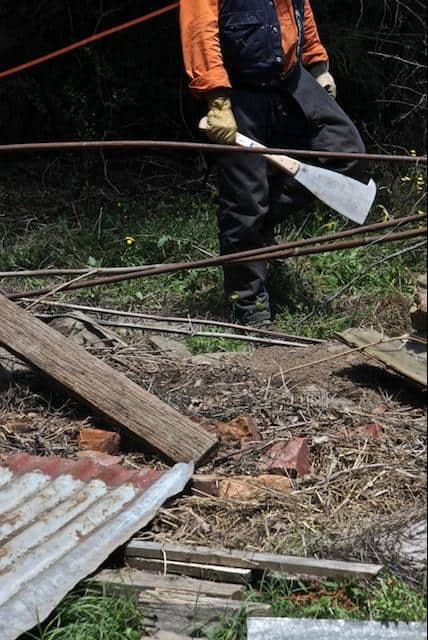My father has a smallish block up in the bush, north-east Victoria in the Ovens Valley. He can’t live there safely anymore, but since he built the place himself and with all the family history it has, it’s a place that has to be retained, and protected from bushfire as much as we reasonably can manage.
 My partner and I, plus Dah (and a coupla friends) spent a few weeks there around Christmas and New Year doing lots of scrub clearing, garden things and general tidying up in readiness for the predicted return to hot dry summers after that naughty La Nina begins to fade. These sort of work trips have been going on over quite a few summers.
My partner and I, plus Dah (and a coupla friends) spent a few weeks there around Christmas and New Year doing lots of scrub clearing, garden things and general tidying up in readiness for the predicted return to hot dry summers after that naughty La Nina begins to fade. These sort of work trips have been going on over quite a few summers.
The big range of jobs on these tidying-up trips range from trimming large branches, working up on roofs, scrub clearing, lots of load shifting, burn-offs, using lots of different powered equipment (chainsaw, scrub-cutters) and dragging out cut scrub with the ute etc etc.
Doing this work has me often giving lots of thought to doing the job efficiently and safely, and observing my own safety stuff-ups. It gives me a chance to reflect on the safety system stuff we spend lots of time lecturing punters on and how practical it all is when there is limited time to get the job done, it’s 30 degrees Celsius, and the humidity is at a zillion; in other words, in work conditions lots of people have to deal with all the time.
I think doing this stuff does good things for my deliberations when I’m advising punters on how to improve their work methods. There’s a lot to be said for “rolling up the sleeves” and getting that real-world measure of what practical risk control is about.
A bunch of key issues keep cropping up when I’m on the job, and as best as I can see they are issues equally applicable for managers and workers to one degree or another:
- It’s a risk assessment Jim, but not as we know it:
The stock standard steps for a risk assessment work; but it has to be virtually intuitive so it can be done in a blink. It’s been a wake-up call to realise just how much background knowledge and understanding of safety techniques you have to be able to draw on to make efficient safety decisions. I think the OH&S-world underestimates just how much of that fundamental knowledge is being called on to get to first base on setting up a job so it’s unlikely to hurt ya. - Proper preparation is essential – and it’s a pain in the bum:
All the well-known prep things are essential for the job to be done safer, thinking ahead about the gear you need, having maintenance up to scratch, working out a plan of attack. But bloody hell, it’s annoying. It slows up getting the job started and it’s just plain fiddly. With no sense (or reinforcement) about how much safer (and ultimately faster) it is to have proper preparation, short-cuts and making-do is a big temptation. - “Can do” can kill ya:
Competency and capacity can get all mixed up. We all like to think “we’re up to it”. It needs a healthy dose of humility to stay healthy. Humility means asking someone to help out with a lift, or being around when working up a ladder or nearby when using chainsaws and just keeping an eye out for ya. Your author was hacking away at some dead blackberry. I spotted a covered-over well me father had sunk years ago. It was covered with some gal roofing sheets of unknown vintage. “No worries” I conclude, ‘know where that is, I can work around it.” Soon after, I realised I’d just walked over the tin without even noticing it. Pull the 3 sheets aside and there was a rotten piece of timber under those sheets doing no more than looking vaguely like a support. A few sheets of iron stopped me dropping 5 metres down the 1 ½ metre wide well shaft. My partner was standing around, didn’t even think to have her keep an eye out in case I’d stopped paying attention. Of course I immediately set up a proper safe cover for the well, and of course I should have done it straight away. But that’s reality, stuff isn’t done perfectly, there is always the potential for another mistake right around the corner.
Over the years working on Dad’s place it’s been a constant reminder that conventional safety thinking is pretty good, but it’s safety thinking that doesn’t come easily; it’s valuable to keep reminding meself about that when advising punters. Perhaps as safety people we can learn more about the challenges if we roll up the sleeves and get a closer look at what our punters have to deal with all the time? Even better, rather than ticking the checklist and scribbling out reports we need to be on the spot, seeing the safety decisions being made right there, getting a realistic perspective of what the punters are dealing with day-to-day. it’s not going to be practical to only ever do our stuff that way, but getting a taste of it every now and then is good value.
And maybe that can help us keep it real for the punter in all our work?
Col Finnie
director
fini:OHS pty ltd
